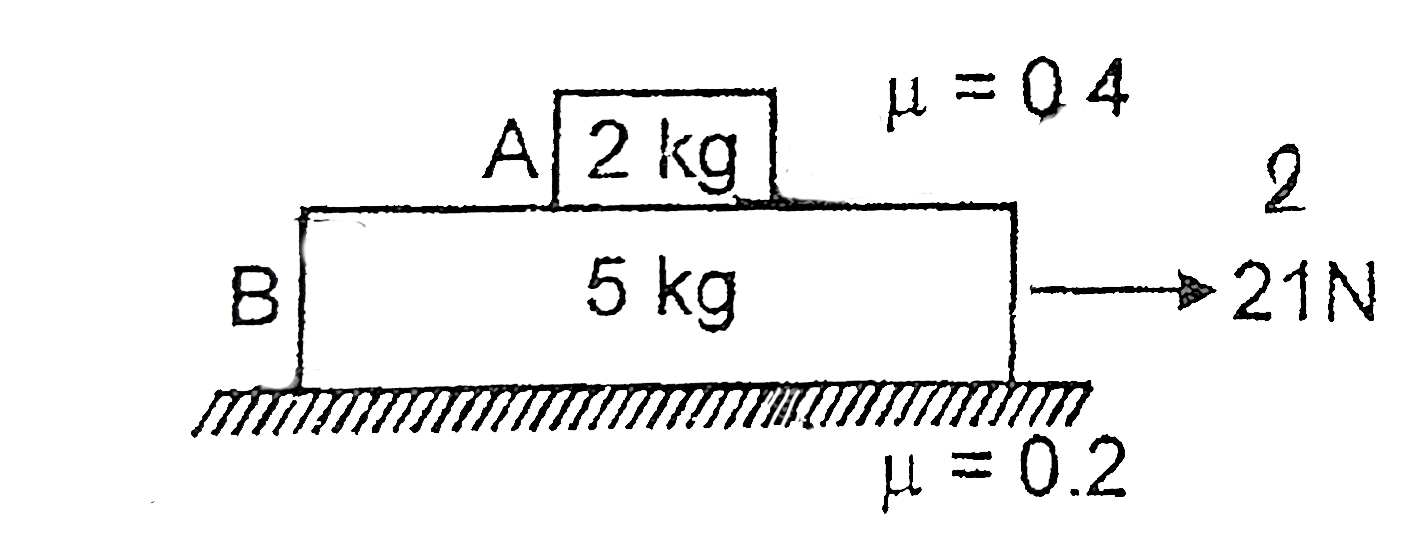A block of mass 500 g is at rest on a horizontal table. What steady force is required to give the block a velocity of 200cms−1 in 4 s?Solution in Tamil
Use F=ma
a=v−ut=200−04=50cm/s2
F=500×50=25,000dyne
Topper's Solved these Questions
- LAW OF MOTION BOOK - FULL MARKSCHAPTER - LAW OF MOTION EXERCISE - ADDITIONAL QUESTIONS SOLVED (SHORT ANSWER QUESTIONS (2 MARKS))
12 Videos
- KINETIC THEORY OF GASESBOOK - FULL MARKSCHAPTER - KINETIC THEORY OF GASESEXERCISE - Addtional Numerical Problems
10 Videos
- MOTION OF SYSTEM OF PARTICLES AND RIGID BODIESBOOK - FULL MARKSCHAPTER - MOTION OF SYSTEM OF PARTICLES AND RIGID BODIESEXERCISE - ADDITIONAL QUESTIONS SOLVED - III (LONG ANSWER QUESTIONS (5 MARKS))
6 Videos
Similar Questions
A man getting down a runnning bus falls forward
View SolutionIf the rms speed of hydrogen molecules at 300K is1930ms−1. Then what is the rms speed of oxygen molecules at 1200K.
View SolutionDerive an expression for center of mass for distributed point masses.
View SolutionA horizontal force of 20 N i sapplied to a block of mass 4 kg resting on a rough horiozontal table. If the blcok does not move on the table, how much fricrtional force the table is applying on the blockgt What can be said about the coefficient of static friction between the block and the table? Take g=m/s^2 .
View SolutionA 250 g block slides on aeroug horizontal table. Find the work donen by the frictinal force in bringing the block to rest if it is initially moving at a speed of 40 cm/s. If the friction coefficient between te table and the block is 0.1 how far does the block move before coming to rest?
View SolutionA block B of mass 5kg rests on a rough horizontal surface (μ=0.2),A block A of mass 2kg rests on block B(μ=0.4). If a horizontal force of 21 N be applied to the block B, what is force (in N) of friction acting between the blocks A and B ? (g=10ms−2)

View SolutionA block of mass 4 kg is resting on a horizontal table and a force of 10 N is applied on it in the horizontal direction. The coefficient of kinetic friction between the block and the table is 0.1. The work done in sqrt(20) s
View Solutionएक क्षैतिज टेबुल पर 250 g द्रव्यमान का एक गुटका फिसलता है। यदि गुटका प्रारंभ में 40 cm/s चाल से चल रहा हो, तो इसको विरामावस्था में लाने तक घर्षण बल द्वारा किया गया कार्य ज्ञात करें। यदि टेबुल तथा गुटके के बीच घर्षण गुणांक वा मान 0. हो, तो विरामावस्था में आने से पूर्व गुटका कितनी दूरी तय करेगा
View SolutionA rectangle block rests on a horizontal table. A horizontal force is applied on the block at a height h above the table to move the block. Does the line of action of the normal force N exerted by the table on block depend on h?
View SolutionA block of mass 500 g is at rest on a horizontal table. What steady force is required to give the block a velocity of 200cms−1 in 4 s ?
View SolutionA rectangle block rests on a horizontal table. A horizontal force is applied on the block at a height h above the table to move the block. Does the line of action of the normal force N exerted by the table on block depend on h?
View SolutionA force of 1 N acts for 4 s on a mass of 500 g. If the mass is initially at rest, find its final velocity.
View SolutionA block of mass 5 kg rests on a table. 8 N horizontal force is applied to push the block. Find out the force of friction between the block and the table. Given μs=0.3andμk=0.2, between the block and the table and g = 10 m.s−2
View SolutionA bullet of mass 50 g , moving with a velocity of 50m⋅s−1 hits and enters a wooden block of mass 2kg and comes to rest within it. The wooden block was initially at rest on a smooth table. Find the final velocity of the wooden block. What are the initial and final kinetic energies of the block-bullet system?
View SolutionA horizontal force of 20 N is applied to a block of mass 4 kg resting on a rough horizontal table. If the block does not move on the table, how much frictional force the table is applying on the block. What can be said about the coefficient of static friction between the block and the table? Take g=10m/s^2 .
View Solution
